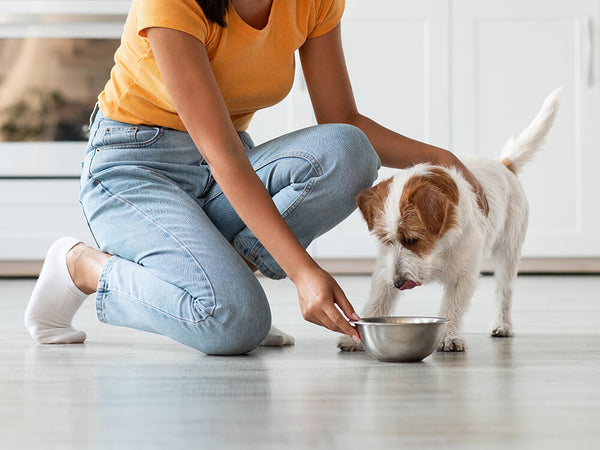Is Your Pet in Discomfort?
Written by: Only Natural Pet Team
Our pets can't tell us when they feel discomfort, so it's up to us to notice the signs and symptoms. In this post, we'll look at some of the most common signs of discomfort in cats and dogs, so you know when your pet requires veterinary care. We'll also share some tips for helping a pet that's experiencing discomfort.
Signs of Discomfort in Pets
There are a variety of signs a pet parent can look for to figure out whether their cat or dog is in discomfort. In this section of the post, we'll highlight a few of the most common.
Lethargy
Lethargy is a lack of energy or enthusiasm for activity. It's a warning sign of discomfort in pets, and can be a sign of injury or illness. Common causes of lethargy include immunity, joint, and gastrointestinal issues. It can also be a sign of more serious conditions like adrenal or cardiovascular issues.
Lethargy that appears suddenly means something is off, especially if your pet is older. If your pet appears lethargic or uninterested in their surroundings, make an appointment with your veterinarian as soon as possible.
Loss of Appetite
Loss of appetite is another sign that your pet could be feeling unwell. If they aren't eating or drinking as usual, it's highly probable that they're in discomfort.
A lack of appetite can indicate a number of health issues in pets. Dental problems such as loose teeth and bleeding gums can also lead to discomfort and loss of appetite.
Weight Loss
Unexpected or rapid weight loss is a symptom of discomfort in cats and dogs that's often easy to spot. There are numerous causes of weight loss in pets. These include dental issues as well as overall health and wellness issues.
Any sudden or unexplained changes in your pet's weight should lead you to a veterinary appointment. Your veterinarian will examine your pet thoroughly and run tests to determine the cause of weight loss.
Unusual Behavior
Sudden changes in your pet's behavior can be a sign of discomfort. For example, if your normally friendly pet suddenly becomes aggressive or avoids interacting with you, it's a sign that something's wrong.
Changes in behavior are often a sign of discomfort and there are many different possible causes. If you notice any sudden changes in your pet's behavior, don't wait to see if the problem gets better. Call your veterinarian and make an appointment as soon as you can.
Changes in Sleeping Patterns
Changes in your pet's sleeping patterns can signal discomfort. Pets may sleep more than usual, become restless at night, or have trouble falling asleep.
Altered sleeping patterns are particularly common in senior pets that are suffering from age-related conditions like joint discomfort or cognitive issues. Any sudden change in your pet's sleep habits should be investigated by a veterinarian.
Difficulty Breathing or Panting Excessively
Breathing difficulties or excessive panting are clear signs that something's wrong. Changes in breathing patterns, such as rapid panting, can indicate a wide range of illnesses.
If your pet is having trouble breathing or panting heavily, call your veterinarian as soon as possible. Your vet will be able to determine the cause and administer appropriate treatment.
Excessive Vocalization
Increased vocalization is a sign that your pet is in discomfort. Dogs will often whine, howl, or bark when they're feeling unwell; whereas cats may meow, yowl, or hiss. This can be in response to an injury, illness, or other underlying health problem.
Any change in your pet's vocalization pattern is cause for concern, especially if it persists or happens suddenly. If you notice your pet making unusual sounds, visit your veterinarian to have them examined.
Loss of Balance or Difficulty Walking
Loss of balance or difficulty walking can indicate discomfort. Pets with injured limbs may have difficulty walking and will often favor one limb over another. Other causes of balance problems include neurological conditions and age-related issues, like joint support.
Any sudden change in your pet's balance or gait should prompt a veterinary appointment. Your vet will be able to determine the cause of the problem and decide on the best course of treatment.
Changes in Grooming Habits
The final sign of discomfort we'll highlight in this post is changes in grooming habits. Pets may groom themselves excessively, lick or chew at an area on their body, or stop self-grooming entirely.
Excessive grooming, licking, and chewing can be a sign of skin and coat issues. A lack of grooming may indicate generalized discomfort or conditions like joint issues. Any changes in your pet's grooming habits warrant a trip to the veterinarian. Your vet will examine your pet and run any necessary tests to check for underlying illnesses and injuries.
How to Help a Pet That’s in Discomfort
It's important to take your pet in for a checkup if you notice any signs of discomfort. The sooner they're diagnosed by a veterinarian, the better your pet's chances of recovering quickly and fully. Your veterinarian will examine your pet carefully and run tests as needed to determine the cause of the problem. Depending on the results, your vet may prescribe medications or other treatments.
Natural remedies and supplements can make great complimentary options as you help your pet regain their form.
During the recovery process, make sure to help your pet deal with discomfort by providing them with a comfortable environment and gentle, loving care. Remember that you're your pet's primary caregiver and they will rely on you for support. Your love, patience, and understanding can make a big difference in how well your pet recovers.
It's also vital to limit exercise and play during this time. Your pet will need lots of rest in order to recover fully and get back to their normal self again. With the right treatment, most pets overcome discomfort within a few days or weeks.
However, chronic discomfort can be very serious and may last for months or even years. In these situations, it's important to consult with your veterinarian who can advise you on appropriate treatment.


















